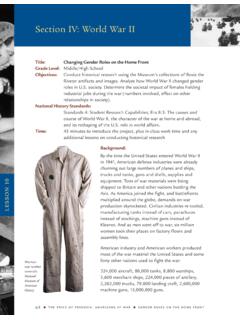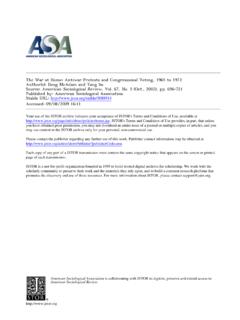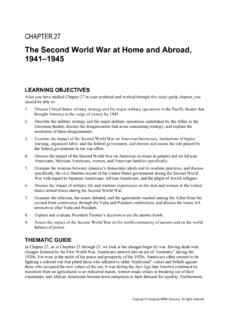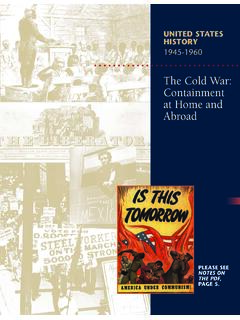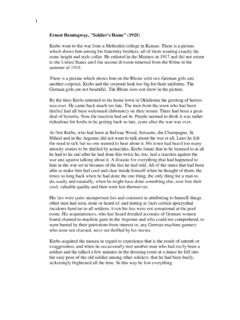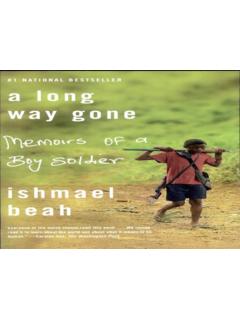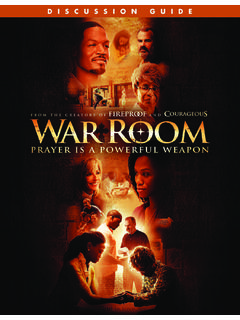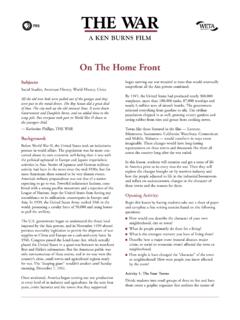Transcription of War Abroad, War at Home - AP United States History - Home
1 War abroad , War at HomeCHAPTER71193_29_ch29_p1048-1091 4/13/10 10:46 AM Page 1048 CHAPTER OUTLINEVIETNAM:AMERICA S LONGEST WARJ ohnson s WarDeeper into the QuagmireThe Credibility GapA GENERATION IN CONFLICT The Times They Are A-Changin From Campus Protest to Mass MobilizationTeenage SoldiersWARS ON POVERTYThe Great SocietyCrisis in the CitiesUrban Uprisings1968 The Tet OffensiveKing, the War, and the AssassinationThe Democratic Campaign The Whole World Is Watching! THE POLITICS OF IDENTITYB lack PowerSisterhood Is PowerfulGay LiberationThe Chicano RebellionRed PowerThe Asian American MovementTHE NIXON PRESIDENCYThe Southern StrategyNixon s War The China Card Domestic PolicyWATERGATEF oreign Policy as ConspiracyThe Age of Dirty TricksThe Fall of the Executive 104971193_29_ch29_p1048-1091 4/13/10 10:46 AM Page 1049 Uptown, Chicago, Illinois uring Freedom Summer of 1964, while teams ofnorthern college students traveled south to join voterregistration campaigns among African Americans, asmall group moved to Chicago to help the city s poor peopletake control of their communities.
2 They targeted a neighborhoodknown as Uptown, a one-mile-square section five miles north ofthe Loop, the city center. The residents, many transplanted fromthe poverty of the Appalachian South, lived in crowded tenementsor in once-elegant mansions now subdivided into tiny, run-downapartments. Four thousand people lived on just one street run-ning four blocks, 20 percent of them on welfare. The studentorganizers intended to mobilize the community so as to demandan end to poverty and the construction of a decent social order. With the assistance of the Packinghouse Workers union,the students formed Jobs or Income Now (JOIN), opened astorefront office, and invited local residents to work with themto demand jobs and better living conditions. They spent hourslistening to people, drawing out their ideas and helping themdevelop scores of programs. They campaigned against MayorRichard Daley s policy of police omnipresence that had a fleetof squad cars and paddy wagons continually patrolling the neigh-borhood.
3 They also helped establish new social clubs, a food-buying cooperative, a community theater, and a health a few years, Uptown street kids had formed the YoungPatriots organization, put out a community newspaper, RisingUp Angry,and staffed free breakfast JOIN was one of ten similar projects sponsored byStudents for a Democratic Society (SDS). Impatient with thenation s chronic poverty and cold war politics, twenty-nine stu-dents from nine universities had met in June 1960 to form anew kind of campus-based political organization. SDS sooncaught the attention of liberal students, encouraging them, as partof the nation s largest college population to date, to make theirvoices heard. By its peak in 1968, SDS had 350 chapters andbetween 60,000 and 100,000 members. Its principle of partic-ipatory democracy with its promise to give people controlover the decisions affecting their lives appealed to a wider fol-lowing of more than a million June 1962, in Port Huron, Michigan, SDS issued a dec-laration of principles, drafted mainly by graduate student TomHayden.
4 We are people .. bred in at least modest comfort,housed now in universities, The Port Huron Statementopened, looking uncomfortably to the world we inherit. The dire effectsof poverty and social injustice, it continued, were not the onlyproblems. A deeper ailment plagued American society. Everyone,including middle-class students with few material wants, suf-fered from a sense of loneliness, estrangement, and alienation. The Port Huron Statementdefined SDS as a new kind of politicalmovement that would bring people out of isolation and intocommunity so that not just the poor but all Americans couldovercome their feelings of powerlessness [and hence] resigna-tion before the enormity of events. SDS began with a campaign to reform the university, espe-cially to disentangle the financial ties between campus-basedresearch programs and the military-industrial complex. In expand-ing to include the nation s cities, SDS sent small groups of stu-dents to live and organize in the poor communities of Boston,Louisville, Cleveland, and Newark as well as Chicago.
5 Ultimately,none of these projects managed to recruit large numbers of peo-ple. Protests against local government did little to combat unem-ployment, and campaigns for better garbage collection or moreplaygrounds rarely evolved into lasting movements. Nevertheless,organizers did succeed, to some degree, in realizing the goalspecified in its slogan: Let the People Decide. By late 1967,Chicago71193_29_ch29_p1048-1091 4/13/10 10:46 AM Page 1050 SDS prepared to leave JOIN in the hands of the people it hadorganized, which was its intention from the , even Lyndon Baines Johnson promoted the ideal ofcivic participation. The Great Society, as the president calledhis domestic program, promised more than the abolition ofpoverty and racial inequality. In May 1964, at the Universityof Michigan, the president described his goal as a society whereevery child can find knowledge to enrich his mind and to enlargehis talents, where the city of man serves not only the needs ofthe body and the demands of commerce but the desire for beautyand the hunger for community.
6 By 1967 the Vietnam War had pushed aside such SDSers had once believed they could work with liberalDemocrats like Johnson, they now interpreted social injustice athome as the inevitable consequence of the president s dangerousand destructive foreign policies. SDS threw its energies intobuilding a movement against the war in Vietnam. PresidentJohnson, meanwhile, pursued a foreign policy that would swal-low up the funding for his own plans for a war on poverty andwould precipitate a very different war at home , Americans againstAmericans. As hawks and doves lined up on opposite sides, theVietnam War created a huge and enduring rift. SDS memberRichard Flacks had warned that the nation had to choosebetween devoting its resources and energies to maintaining mil-itary superiority and international hegemony or rechannelingthose resources and energies to meeting the desperate needs ofits people. Ultimately, even President Johnson himself under-stood that the bitch of a war in Asia ruined the woman I reallyloved the Great Society.
7 The dream of community did not vanish, but consensusbecame increasingly remote by the late 1960s. By this time, par-ents and children were at odds over values and aspirations, urbanriots were rocking the nation, and political leaders were beingstruck down by assassins bullets. New protest groups BlackPower, Women s Liberation, Gay Liberation, as well as Chicano,Native American, and Asian were staking out a highly charged politics of identity. Political conservatives managed to tri-umph in the election of Richard Nixon, who went on to disgracethe office. Meanwhile, the United States continued to fight and eventually lost the longest war in its History . WAR abroad , WAR AT home , 1965 1974 CHAPTER 291051 Widening involvement in the war in Vietnam The sixties generation and the antiwar movementPoverty and urban crisisThe election of 1968 The rise of liberation movementsThe Nixon presidency and the Watergate conspiracyGuideline EVENTSled up to andcontributed to involvement in Vietnam?
8 Vietnam: America s Longest WarThe Vietnam War had its roots in the Truman Doctrine and its goal of con-taining communism (see Chapter 26). After the defeat of the French bythe Communist forces of Ho Chi Minh in 1954, Vietnam emerged as amajor zone of cold war contention. President John Kennedy called it the corner-stone of the Free World in Southeast Asia, the keystone in the arch, the finger inthe dike, a barrier to the spread of communism throughout the region and per-haps the world. President Lyndon Johnson sounded the same note at the begin-ning of his presidency. With American security at stake, he insisted, Americanshad little choice but to fight for the principle for which our ancestors fought inthe valleys of Pennsylvania. 71193_29_ch29_p1048-1091 4/13/10 10:46 AM Page 1051 Vietnam was not Valley Forge, however, and the United States ultimately paida huge price for its determination to turn back communism in Indochina. Morethan 50,000 Americans died in an unwinnable overseas war that only deepened divi-sions at s WarAlthough President Kennedy had greatly increased the number of military advisorsin South Vietnam (see Chapter 27), it was his successor, Lyndon B.
9 Johnson, whomade the decision to engage the United States in a major war there. At first, Johnsonsimply hoped to stay the course. Facing a presidential election in November 1964, heknew that a major military setback would cripple his election campaign. But he wasequally determined to avoid the fate of President Truman, who had bogged downpolitically after losing China to communism and producing a stalemate in the winter and spring of 1964, as conditions grew steadily worsein South Vietnam, Johnson and his advisors quietly laid the groundwork for a sustainedbombing campaign against North Vietnam. In early August, they found a pretext toset this plan in motion. After two destroyers in the Gulf of Tonkin, off the coastof North Vietnam, reported attacks by North Vietnamese patrol boats, Johnsonordered retaliatory air strikes against bases in North now appealed to Congress to pass a resolution giving him the author-ity to take all necessary measures and all necessary steps to defend armedforces and to protect Southeast Asia against aggression or subversion.
10 This TonkinGulf resolution, secretly drafted six weeks before the incident for which it was named,passed the Senate on August 7 with only two dissenting votes and moved unanimouslythrough the House. It served, in Undersecretary of State Nicholas Katzenbach swords, as the functional equivalent of a declaration of , Johnson campaigned for the presidency in 1964 with a call for restraintin Vietnam. He assured voters that we are not about to send American boys nine orten thousand miles away from home to do what Asian boys ought to be doing forthemselves. This strategy helped him win a landslide victory over conservativeRepublican Barry Goldwater of Arizona, who had proposed the deployment of nuclearweapons in the election behind him, Johnson now faced a hard decision. The limitedbombing raids against North Vietnam had failed to slow the movement of theCommunist Vietcong forces across the border into the South. Meanwhile, the gov-ernment in Saigon, the capital city of South Vietnam, appeared near collapse.
